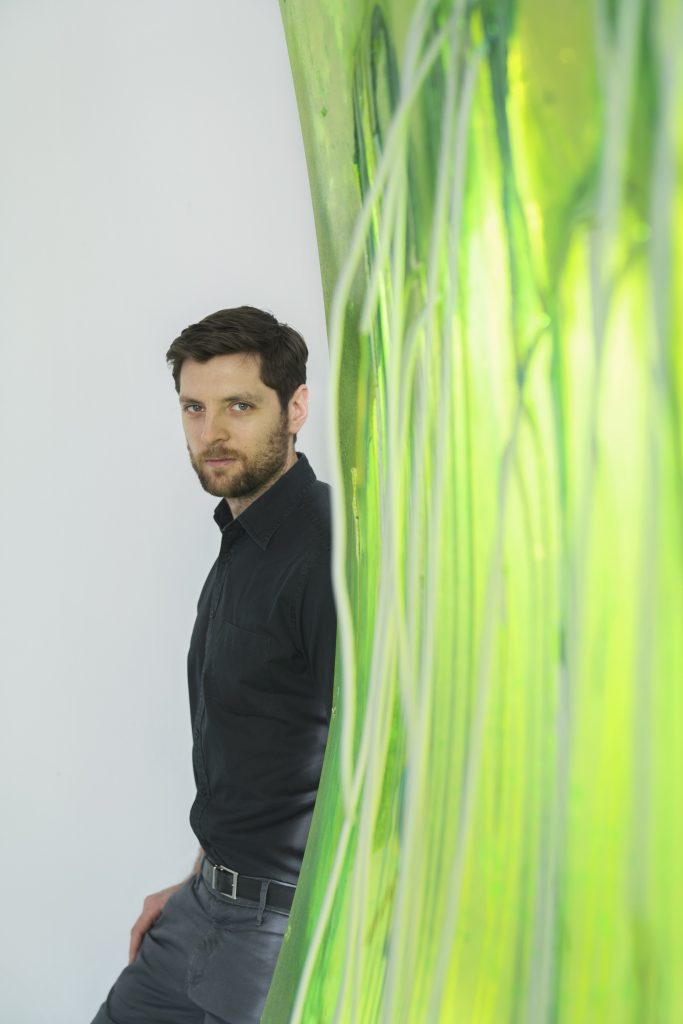Thinking about his Mortality
The creations of the German artist Philipp Fürhofer are causing an international sensation. Currently, his dystopian scenes are touring from Montréal via Munich to the Louvre in Paris in an exhibition about the fashion designer Thierry Mugler. Artpaper visited Philipp in his Berlin studio.
With Philipp Fürhofer, there is always something going on. Nevertheless, throughout the conversation in his tidy workshop behind Berlin’s main railway station Hauptbahnhof, he is a calming influence. While one of his lightboxes is turning on, his alert mind formulates an artistic vision: “in drawings, I experiment a lot; I try to combine different techniques and media that don’t really belong together – so it’s always the dissolution of the static,” he says quite appropriately. As if the pictorial design with oil paint, Plexiglas, mirrors and cables did not exhaust him, he also creates opulent stage sets for operas. Everything has several layers for Philipp Fürhofer.

© Kunsthalle München, Photo by Michael Naumann / Tiefenpixel
He grew up in a family of teachers in Augsburg, Bavaria – he graduated from an artistic grammar school, learned piano and attended Wagner operas as a pupil. But the small town became too small for him, and he travelled to Berlin to study fine art. A story like many, if it weren’t for the heart valve transplant, which helped him at the age of 24 to overcome a life-threatening congenital heart defect.
Death is negated in our society
This existential incision into his body made the budding artist think about his mortality. Thus, the life-threatening diagnosis is still present in the 38-year-old’s works today: very strikingly as an X-ray, or as cyborgs, persons equipped with implants, that populate Fürhofer ‘s creations. “In art, the subject must never become private,” he says. “But it is a reflection of our own mortality, just as religion used to take it over”.
Fürhofer gets into philosophy: “there is a negation of death in our society. We can’t rationalise it away, even if we digitally store ourselves to infinity.” As an affected person, he asked himself what the insertion of artificial heart valves would make him. Transplants could lead to absurd moments, but on the other hand, they saved lives, as they did with him. So the fusion of organic and technical elements became the leitmotif of his work.

Photo: © Patrice Stable
The woman as a fashion robot
A current example is the Thierry Mugler exhibition, Couturissime, in the Kunsthalle Munich (showing until 28 February 2021). Fürhofer has designed rooms for this internationally touring retrospective of the French fashion designer, director, photographer and perfumer. One enters a semi-dark, dystopian scene described as Gynoïd Couture & Futuriste. The woman as a fashion robot is a characteristic of Mugler’s creations. One thinks of his iconic music video for George Michael’s Too Funky (1992), in which the most famous top models presented their luxury bodies in robot costumes. These strong, comic-like, overdrawn amazons walk the catwalk in bustiers seamlessly fitted to their bodies – the chrome parts shine like car bodies.
Mugler’s perfect creations, in turn, appealed to Fürhofer to break the effect with his “simple, trashy means”. For the exhibition staging, he installed neon tubes, painted mirrors and a weathered metal wall riddled with “bullet holes”, through which light breaks from behind, “like stars, like the cosmos”. The transformation of the scrap into something aesthetic is what interests him. “Junk has its own beauty,” he says. “These are romantic utopias in the best sense of the word: our surroundings are over-developed, but we still have a longing for the environment”.
With his depictions, the artist challenges the viewer to perceive himself – in an artificially over-moulded environment or an artificially designed body: “That’s not bad, you just have to know about it and know your limits,” he says. People’s “self-produced dung”, the waste culture, also stimulates his creativity. Despite some gloomy images, Fürhofer is a positive-thinking person.
Reverse glass paintings for private collectors
Smaller works, for contemporary art lovers, will be shown again in 2021 at his Berlin gallery Judin in Potsdamer Straße. Prices start at around €2,500 for a smaller reverse glass painting on Plexiglas; for a wall-dominating lightbox they are €60,000 and more. This year, his multifaceted work was honoured in an illustrated book published by the curator Thierry-Maxime Loriot. (Dis)Illusions is its title and he was able to count on contributions from the art historian Sir Norman Rosenthal and even the singer-songwriter Rufus Wainwright. This shows the breadth of the ‘Fürhofer fans’ who feel addressed by his art.
While his opera productions, like Carmen, are shifted into the future due to Corona, Fürhofer finds more time to work in his studio. He tries not to give his works a daily touch, but to continue to depict human sensitivities. “It would be too narrow for me to pin it on Covid-19,” he says. “After all, we are not immortal, even if the pandemic is over, the finite nature of resources will always remain there – as danger and vulnerability.”
—
Exhibition: Thierry Mugler, Couturissime, Kunsthalle Munich, until 28 February 2021. www.kunsthalle-muc.de. From June 2021 at the Musée des Arts Décoratifs/Palais du Louvre, Paris.
www.philippfuerhofer.de








